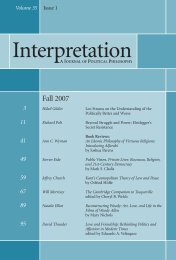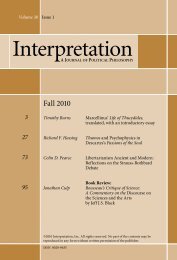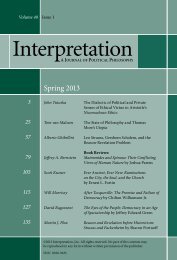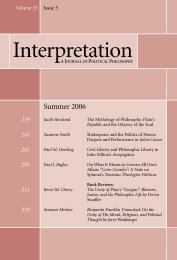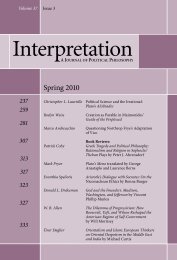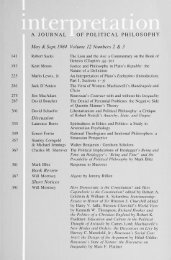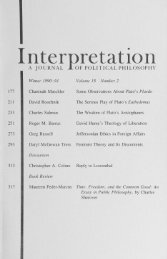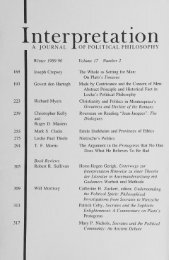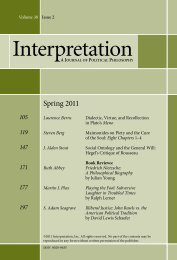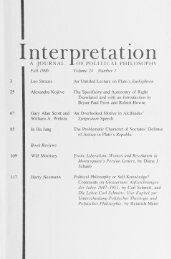Teaching and the Decline of Liberty at Credulity and Curiosity in A ...
Teaching and the Decline of Liberty at Credulity and Curiosity in A ...
Teaching and the Decline of Liberty at Credulity and Curiosity in A ...
Create successful ePaper yourself
Turn your PDF publications into a flip-book with our unique Google optimized e-Paper software.
-<br />
Man <strong>and</strong> N<strong>at</strong>ure <strong>in</strong> Pl<strong>at</strong>o's Phaedo 159<br />
THE STRUCTURE OF THE DIALOGUE<br />
The Phaedo has a tightly ordered composition, despite first appearances to<br />
<strong>the</strong> contrary. After Socr<strong>at</strong>es has made an "apology"<br />
which his companions f<strong>in</strong>d<br />
unacceptable, he undertakes an actual exam<strong>in</strong><strong>at</strong>ion (cf. 70c) <strong>in</strong>to <strong>the</strong> question <strong>of</strong><br />
whe<strong>the</strong>r <strong>and</strong> how <strong>the</strong> soul exists after de<strong>at</strong>h. He <strong>of</strong>fers three major pro<strong>of</strong>s th<strong>at</strong> <strong>the</strong><br />
soul exists after de<strong>at</strong>h, which I will refer to as "<strong>the</strong> n<strong>at</strong>ure<br />
lection<br />
argument," section."<br />
<strong>and</strong> "<strong>the</strong> noncomposite soul<br />
argument,"<br />
"<strong>the</strong> recol<br />
Socr<strong>at</strong>es beg<strong>in</strong>s with <strong>the</strong> most basic hypo<strong>the</strong>sis about soul <strong>in</strong> <strong>the</strong> n<strong>at</strong>ure argu<br />
ment <strong>and</strong> <strong>the</strong>n advances upward through more <strong>and</strong> more complex ones <strong>in</strong> <strong>the</strong> rec<br />
ollection argument <strong>and</strong> <strong>in</strong> parts <strong>of</strong> <strong>the</strong> noncomposite soul section, <strong>in</strong> response to<br />
<strong>the</strong> <strong>in</strong>completeness <strong>in</strong> each preced<strong>in</strong>g argument. In <strong>the</strong> center, form<strong>in</strong>g a l<strong>in</strong>k be<br />
tween <strong>the</strong> first <strong>and</strong> last parts <strong>of</strong> <strong>the</strong> dialogue are two counter-arguments (pre<br />
sented by Socr<strong>at</strong>es'<br />
<strong>in</strong> opposition to Socr<strong>at</strong>es'<br />
two primary <strong>in</strong>terlocutors, Simmias <strong>and</strong> Cebes) which st<strong>and</strong><br />
pro<strong>of</strong> th<strong>at</strong> <strong>the</strong> soul must always exist. These counterar<br />
guments address <strong>the</strong> issue <strong>of</strong> <strong>the</strong> causal significance <strong>of</strong> soul <strong>and</strong> <strong>the</strong> question <strong>of</strong><br />
whe<strong>the</strong>r soul is someth<strong>in</strong>g formed by body or whe<strong>the</strong>r <strong>in</strong>stead body is formed by<br />
soul.<br />
In answer to <strong>the</strong> counterarguments Socr<strong>at</strong>es f<strong>in</strong>ally gives an autobiographical<br />
account <strong>of</strong> his own search for causes <strong>and</strong> his new "m<strong>in</strong>gled<br />
toge<strong>the</strong>r"<br />
method <strong>of</strong><br />
<strong>in</strong>quiry a method which he clearly has used already <strong>in</strong> <strong>the</strong> first part <strong>of</strong> <strong>the</strong> dia<br />
logue. From this po<strong>in</strong>t on Socr<strong>at</strong>es makes a complic<strong>at</strong>ed retre<strong>at</strong> from some <strong>of</strong><br />
<strong>the</strong> earlier conclusions about <strong>the</strong> soul,<br />
<strong>and</strong> <strong>the</strong> discourse <strong>the</strong>n culm<strong>in</strong><strong>at</strong>es <strong>in</strong><br />
an acknowledged myth (cf. nob) about <strong>the</strong> <strong>in</strong>dividual's journey<br />
after de<strong>at</strong>h.<br />
None<strong>the</strong>less, taken toge<strong>the</strong>r <strong>the</strong> various arguments encompass a very precise<br />
<strong>at</strong>tempt <strong>at</strong> account<strong>in</strong>g philosophically for <strong>the</strong> order <strong>of</strong> <strong>the</strong> whole <strong>in</strong> a certa<strong>in</strong><br />
manner.1<br />
There are two major undercurrents, two motiv<strong>at</strong>ions or objectives, th<strong>at</strong> pull<br />
<strong>the</strong> dialogue <strong>in</strong> various directions <strong>and</strong> move it along. One <strong>of</strong> <strong>the</strong>se (<strong>the</strong> current<br />
which is more visible) is th<strong>at</strong> this dialogue answers to <strong>the</strong> need <strong>of</strong> most human<br />
be<strong>in</strong>gs to believe th<strong>at</strong> <strong>the</strong>y will somehow survive de<strong>at</strong>h. This is wh<strong>at</strong> his compan<br />
ions <strong>in</strong>itially dem<strong>and</strong> <strong>of</strong> Socr<strong>at</strong>es (cf. 69e-70b) a pro<strong>of</strong> th<strong>at</strong> his <strong>and</strong> <strong>the</strong>ir souls<br />
will exist after de<strong>at</strong>h <strong>and</strong> it is <strong>the</strong> requirement <strong>the</strong> myths seek to s<strong>at</strong>isfy, <strong>and</strong><br />
<strong>the</strong> arguments <strong>at</strong> least on <strong>the</strong> surface. From <strong>the</strong> st<strong>and</strong>po<strong>in</strong>t <strong>of</strong> <strong>the</strong> drama <strong>of</strong> <strong>the</strong><br />
Phaedo, this requirement is <strong>the</strong> motiv<strong>at</strong><strong>in</strong>g force beh<strong>in</strong>d <strong>the</strong> vast <strong>in</strong>quiry <strong>in</strong>to <strong>the</strong><br />
n<strong>at</strong>ure <strong>of</strong> <strong>the</strong> soul. In addition, Socr<strong>at</strong>es carries on a more hidden dialogue with<br />
1 . This underly<strong>in</strong>g <strong>at</strong>tempt is obscured because <strong>the</strong> dialogue does rely on Pythagorean <strong>and</strong> Or<br />
phic mystical traditions to give <strong>the</strong> appearance <strong>of</strong> proven hav<strong>in</strong>g th<strong>at</strong> <strong>the</strong> <strong>in</strong>dividual soul must always<br />
exist. Unfortun<strong>at</strong>ely comment<strong>at</strong>ors have been too will<strong>in</strong>g to accept <strong>the</strong>se elements <strong>at</strong> <strong>the</strong>ir face value;<br />
<strong>the</strong>refore, <strong>the</strong>y stop <strong>at</strong> a po<strong>in</strong>t where <strong>the</strong> arguments appear <strong>in</strong>consistent or merely wrong. They are<br />
<strong>the</strong>n forced to <strong>the</strong> logical conclusion th<strong>at</strong> Socr<strong>at</strong>es or Pl<strong>at</strong>o or both are mystic <strong>and</strong> doctr<strong>in</strong>aire "philos<br />
ophers."<br />
See, for <strong>in</strong>stance, Pl<strong>at</strong>o's Phaedo, ed. by John Bumet with <strong>in</strong>troduction <strong>and</strong> notes (Oxford:<br />
Clarendon Press, 191 1), pp. liv-lv, <strong>and</strong> Pl<strong>at</strong>o's Phaedo, trans, by R. Hackforth with <strong>in</strong>troduction<br />
<strong>and</strong> commentary (Cambridge, Engl<strong>and</strong>: University Press, 1972), pp. 3-6.



